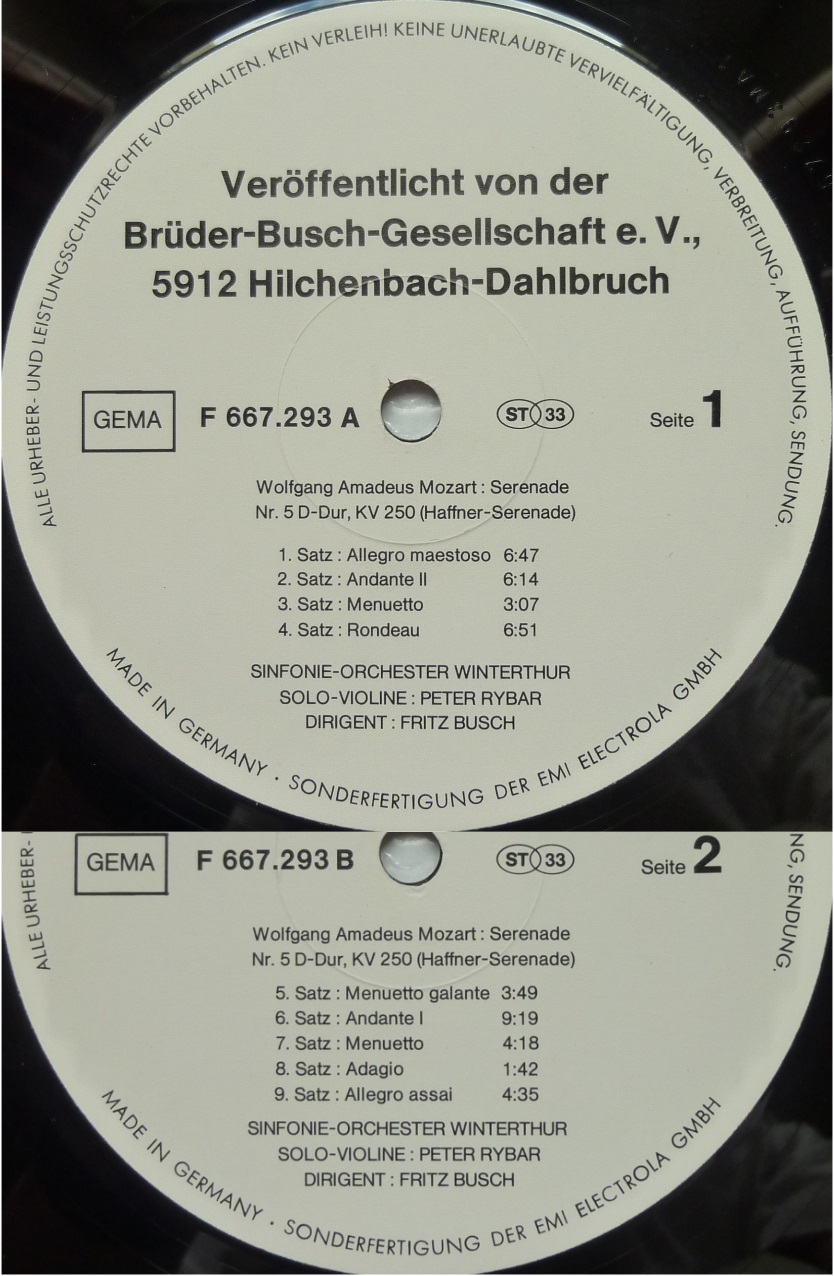Étiquette : Mozart
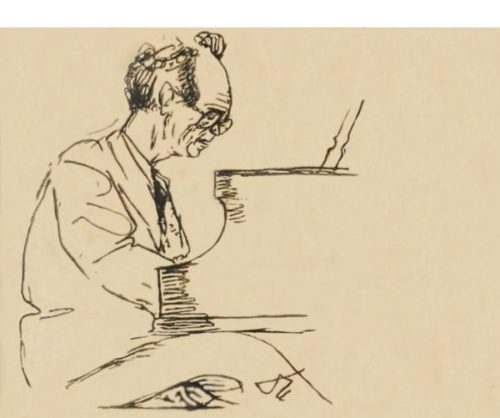
Rudolf Serkin Steinway piano – Guido Cantelli New York Philharmonic (NYPO)
Mozart Concerto n°20 K. 466 (Cadenzas: Beethoven) – Carnegie Hall March 27, 1953
Beethoven Concerto n°1 Op.15 (Cadenza: Beethoven Version III) – Carnegie Hall March 29, 1953
Source: Bande / Tape – 19 cm/s / 7.5 ips
L’invitation de nombreux solistes faisait partie intégrante de la politique des programmes du New York Philharmonic (NYPO). Cantelli a commencé à diriger le NYPO en janvier 1952, et très vite, un nombre appréciable de grands pianistes se sont produits avec lui: successivement de 1952 à 1956, Rudolf Firkušný, Nicole Henriot-Schweitzer, Claudio Arrau, Rudolf Serkin, Robert Casadesus, Walter Gieseking et Wilhelm Backhaus, et une série d’enregistrements radiophoniques nous permet d’apprécier ses qualités exceptionnelles en tant que partenaire, bien plus qu’accompagnateur.
Rudolf Serkin a fêté son cinquantième anniversaire le 28 mars 1953. Avec Guido Cantelli et le NYPO, il a joué les 26 et 27 le Concerto n°20 K.466 de Mozart et le 29, le Concerto n°1 Op.15 de Beethoven. Le jour même de son anniversaire, il a répété le concerto de Beethoven avec l’orchestre.
D’habitude, la Radio ne retransmet que le concert du dimanche dont le programme, comme ici, diffère de ceux qui ont été joués au cours de la semaine. Nous avons cependant la chance d’avoir un enregistrement du concerto de Mozart joué le vendredi 27.
Les critiques musicaux new-yorkais se sont accordés pour trouver mémorable l’interprétation par Serkin du concerto de Mozart et pour louer la direction de Cantelli.
Harris Goldsmith, qui a assisté au concert du 29 alors qu’il était encore étudiant en piano, a relaté bien plus tard à quel point l’interprétation beethovénienne de Serkin, portée par les tempi rapides et fougueux de Cantelli, qui lui rappelaient ceux de Toscanini (avec Ania Dorfmann), était à la fois musicale et intense.
On notera dans le largo du concerto de Beethoven la finesse du dialogue entre le piano et le clarinettiste solo du NYPO, Robert Mc Ginnis.

Inviting a large number of soloists was an integral part of the schedule of the New York Philharmonic (NYPO). Cantelli started conducting the NYPO in January 1952, and very soon, a significant number of great pianists performed with him: successively from 1952 to 1956, Rudolf Firkušný, Nicole Henriot-Schweitzer, Claudio Arrau, Rudolf Serkin, Robert Casadesus, Walter Gieseking and Wilhelm Backhaus, and a series of broadcast recordings allows us to appreciate his exceptional qualities as a partner, rather than an accompanist.
Rudolf Serkin’s fiftieth birthday was on March 28, 1953. With Guido Cantelli and the NYPO, he played Mozart’s Concerto n°20 K.466 on the 26 and 27, and on the 29, Beethoven’s Concerto n°1 Op.15. On the birthday itself, he rehearsed the Beethoven concerto with the orchestra.
Usually, the Radio broadcasts only the Sunday concert whose program, as here, is different from those that have been played during the week. We are however lucky to have a recording of the Mozart’s concerto played on the Friday 27.
New York music critics agreed to find Serkin’s performance of the Mozart concerto memorable and to praise Cantelli’s conducting.
Harris Goldsmith, who attended the concert on the 29 when he was still a piano student, remembered many years later to what extend Serkin’s Beethoven performance, uplifted by Cantelli’s fast and fiery tempi, which reminded him of Toscanini’s (with Ania Dorfmann), was both musical and intense.
Note in the largo of the Beethoven’s concerto the delicacy of the dialog between the piano and the solo clarinettist of the NYPO, Robert Mc Ginnis.

Cadences/Cadenzas: Ferrucio Busoni
Walter Gieseking, Baldwin piano – Guido Cantelli New York Philharmonic (NYPO)
Carnegie Hall – March 6, 1955
Source: Bande / Tape – 19 cm/s / 7.5 ips
Cette interprétation du 6 octobre 1955 documente la rencontre entre Gieseking et Cantelli. C’est le retour de Gieseking avec le NYPO pour la première fois depuis 1939, et c’est une réussite. L’influence réciproque entre les deux interprètes conduit à une interprétation mémorable qui est on ne le peut mieux décrite que par le critique américain Bernard H. Haggin (1900-1987) dans son article de 1968 en hommage à Cantelli:
‘A l’époque, j’ai trouvé que beaucoup d’interprétations de Cantelli étaient merveilleuses; et merveilleux est le mot pour certaines que j’ai entendues récemment, en particulier celle du Concerto pour piano de Mozart K.467. Dans mon expérience, seul Toscanini apportait aux solistes des contextes orchestraux aussi beaux et aussi efficaces que ceux de Cantelli; et dans mon expérience, Toscanini a fourni le précédent pour la chose extraordinaire qui se passe dans l’interprétation par Cantelli du concerto K.467. A un concert du New York Philharmonic en 1934, j’ai entendu Toscanini diriger les concertos K.467 et K.466 avec José Iturbi en soliste, et j’ai entendu Iturbi—sous l’impulsion de la personnalité et du magnétisme du chef—rivaliser avec le jeu puissant de l’orchestre avec un jeu personnel qui était remarquablement différent de son jeu embelli habituel, un style de salon, pour jouer Mozart.
Et la même chose se produit dans l’exécution par Cantelli du concerto K.467. Ce que l’on s’attend à entendre après l’introduction orchestrale superbement exécutée est le style miniature finement ciselé pour jouer Mozart que l’on entend toujours de la part de Gieseking; mais ce que l’on entend à la place, ce sont une énonciation forte et des phrasés forts pour jouer la mélodie, et des doigtés forts pour les séquences de notes rapides et les figurations qui doivent avoir surpris Gieseking comme ils doivent avoir surpris ses auditeurs en 1955 au concert du New York Philharmonic. Jamais auparavant, il n’avait joué Mozart comme cela; et il l’a fait sous la même impulsion de la part de Cantelli que celle que Toscanini avait exercé sur Iturbi. Sous cette impulsion, Iturbi a réussi, et Gieseking réussit, dans l’extraordinaire Andante ce que je n’ai entendu d’aucun autre pianiste au concert: une énonciation et une articulation de la longue cantilène du piano qui soit comparable avec l’enregistrement discographique de Schnabel. Et le jeu de Gieseking dans cette cantilène, contrairement à celui de Schnabel, s’exprime dans le contexte du jeu superbe de la partie orchestrale qui est constamment active—par exemple, les commentaires poignants des bois qui intensifient certaines des énonciations du piano.’

![]()

This October 6, 1955 concert illustrates the meeting between Gieseking and Cantelli. It is Gieseking’s return with the NYPO for the first time since 1939 and it is a success. The reciprocal influence between both musicians leads to a memorable performance best described by US critic Bernard H. Haggin (1900-1987) in his 1968 tribute to Cantelli:
‘Many of Cantelli’s performances I found marvelous at the time; and marvelous is the word for those I have heard recently—in particular the one of Mozart’s Piano Concerto K.467. Only Toscanini, in my experience, provided soloists with orchestral contexts as beautifully made and as effective as Cantelli’s; and Toscanini provided the one precedent in my experience for the astounding thing that happens in Cantelli’s performance of K.467. At a New York Philharmonic concert in 1934, I heard Toscanini perform K.467 and 466 with José Iturbi as soloist, and heard Iturbi—under the compulsion of the personality and magnetism of the man on the podium—match the orchestra’s powerful playing with playing of his own that was strikingly different from his customary prettified salon-style playing of Mozart.
And the same thing happens in Cantelli’s performance of K.467. What one expects to hear after the superbly performed orchestral introduction is the finely chiseled miniature-scale playing of Mozart that one always heard Gieseking do; but what one hears instead is a strongly enunciated, strongly phrased playing of melody, a strong-fingered execution of runs and figuration, that may have amazed Gieseking as it must have amazed his listeners at the New York Philharmonic concert in 1955. He had never played Mozart that way before; and he did so then under the same compulsion from Cantelli as Toscanini had exercised on Iturbi. Under that compulsion, Iturbi achieved, and Gieseking achieves, in the extraordinary Andante what I have heard live from no other pianist: an enunciation and articulation of the piano’s long cantilena comparable with Schnabel’s in his recorded performance. And Gieseking’s playing of this cantilena, unlike Schnabel’s, is heard in the context of the superb playing of the constantly active orchestral part—e.g., the poignant woodwind comments intensifying certain of the piano’s statements.’

Le label Maestro Editions de Richard Chlupaty propose sous forme d’un album de 2 CD (ME 221) l’enregistrement intégral du concert Mozart donné le 12 juin 1953 au Palais des Fêtes de Strasbourg par Edwin Fischer et l’Orchestre Municipal de Strasbourg, au cours du Festival de Strasbourg 1953.
Pour plus d’information, lire l’article en cliquant sur le lien:
Richard Chlupaty’s label Maestro Editions has just published a 2 CD album (ME 221) comprised of the complete recording of the Mozart concert given on 12 June 1953 at the Strasbourg ‘Palais des Fêtes’ by Edwin Fischer and the ’Orchestre Municipal de Strasbourg’, as part of the ‘Festival de Strasbourg 1953’.
To know more about this issue, please click on this link:

A la demande amicale d’un habitué de ce blog / At the request of a friend of this blog:
Mozart Divertimento n°15 en si bémol majeur K.287 « Zweite Lodronische Nachtmusik »
Wiener Oktett: Willi Boskovsky, Violine I; Philipp Matheis, Violine II;
Günther Breitenbach, Bratsche; Johann Krump, Kontrabass;
Josef Veleba & Josef Lackner, Horn
Wien Musikverein Brahmssaal – 4-7 April 1955
Pr: Victor Olof & Peter Andry; Eng: Cyril Windebank
Source: 33t/LP: London LL 1239
Violon I: Willi Boskovsky (1908-1991) « Stimmführer » des Violons I de 1934 à 1938, puis Konzertmeister de 1938 à 1970; Violon I du Wiener Oktett de 1947 à 1959
Violon II: Philipp Matheis (1918-1975) « Stimmführer » des violons I de 1954 à 1958, puis de 1968 à 1974; Violon II du Wiener Oktett de 1947 à 1968
Alto: Günther Breitenbach (1911-1992) « Stimmführer » de 1958 à 1977; membre du Wiener Oktett de 1947 à 1972
Contrebasse: Johann Krump (1889-1974) « Stimmführer » de 1938 à 1951 Contrebasse solo de 1951 à 1955; membre du Wiener Oktett de 1947 à 1964
Cor I: Josef Veleba (1914-1997) Cor solo de 1940 à 1968; 3ème Cor de 1968 à 1971, puis 4ème Cor de 1971 à 1977; membre du Wiener Oktett de 1947 à 1967
Cor II: Josef Lackner (1908-1996) 4ème Cor de 1941 à 1942, puis 2ème Cor de 1942 à 1973
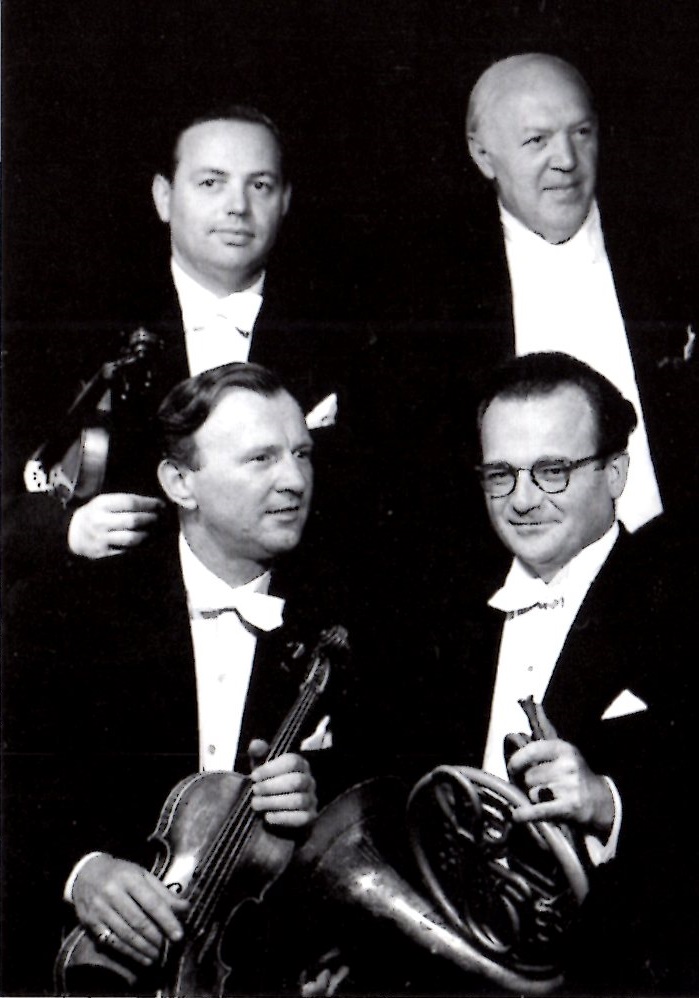
1er rang/First row: Willi Boskovsky & Josef Veleba / 2ème rang/Second row: Philipp Matheis & Johann Krump
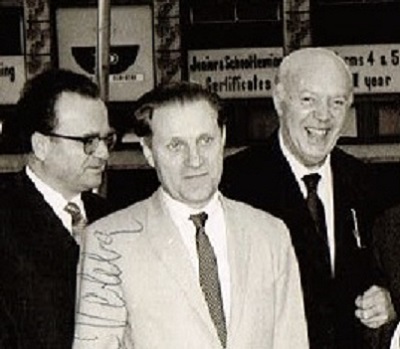
Josef Veleba, Günther Breitenbach & Johann Krump (Johannesburg 1962)
Ce Divertimento, écrit à l’origine pour un sextuor (2 violons, alto, contrebasse et 2 cors), est le plus souvent joué dans une version orchestrale, et bien qu’il en existe des enregistrements sous la baguette de chefs mozartiens reconnus (Walter, Toscanini, Karajan, Münchinger, Vegh etc…, sans oublier Willi Boskovsky et son Wiener Mozart Ensemble), la version de musique de chambre reste de loin préférable.
Et ici, son interprétation par des musiciens fondateurs en 1947 du Wiener Oktett, dans un style proche de la musique populaire, convient particulièrement à cette œuvre qui utilise deux thèmes favoris du public: « Heissa, hurtig, ich bin Hans » (« Allez, hop-là, je suis Hans ») dans l’Andante grazioso con Variazioni (II) et, avec beaucoup d’humour, « D’Bauerin hat d’Katz verlor’n » (« La fermière a perdu son chat ») dans le dernier mouvement (VI).
Si on parle beaucoup à propos de la musique de cette époque d’interprétations historiquement informées, il s’agit d’une logique musicologique qui, pour rigoureuse qu’elle soit, n’est pas forcément plus pertinente que la tradition d’interprétation issue en ligne directe de la musique populaire et illustrée ici par des musiciens du plus grand orchestre d’Autriche.
Cette version de 1955 qui n’existe qu’en mono a été publiée en 1956 à l’occasion du bi-centenaire de la naissance de Mozart (puis en 1957), mais, comme le Wiener Oktett a enregistré une nouvelle version stéréophonique en 1962 (avec comme premier violon Anton Fietz qui a succédé en 1959 à Willi Boskovsky), ces microsillons n’ont jamais été ré-édités. Les reprises ultérieures sont un CD paru au Japon en 1999 (POCL4638) et le double Album Decca Eloquence paru en 2011 (4804328).
La première tentative recensée d’une prise de son stéréophonique à Vienne par Decca a suivi immédiatement cet enregistrement. Il s’agit de l’ « Eroïca » de Beethoven avec le WPO sous la direction d’Erich Kleiber, captée à la Musikvereinsaal du 11 au 14 avril 1955, avec les mêmes producteurs et comme ingénieurs du son Cyril Windebank et Gil Went pour la mono, et Roy Wallace pour la stéréo. En raison du résultat jugé insatisfaisant, la bande stéréo a malheureusement été effacée.
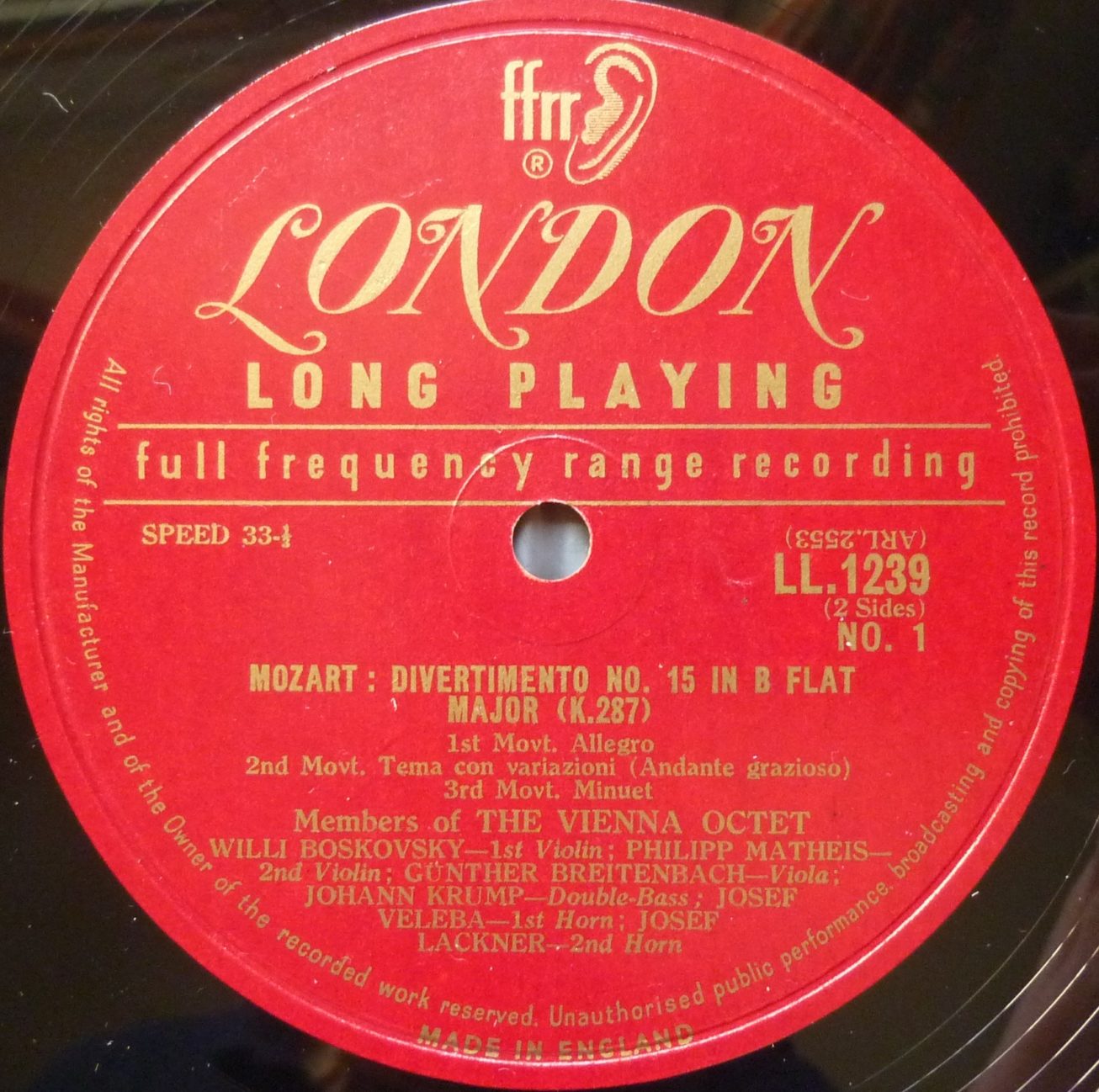

Mozart Divertimento n°15 in B flat major K.287 « Second Lodron Nightmusic »
Wiener Oktett: Willi Boskovsky, Violine I; Philipp Matheis, Violine II;
Günther Breitenbach, Bratsche; Johann Krump, Kontrabass;
Josef Veleba & Josef Lackner, Horn
Wien Musikverein Brahmssaal – 4-7 April 1955
Pr: Victor Olof & Peter Andry; Eng: Cyril Windebank
Source: 33t/LP: London LL 1239
Violin I: Willi Boskovsky (1908-1991) « Stimmführer » of Violins I from 1934 to 1938, then Konzertmeister from 1938 to 1970; Violin I of Wiener Oktett from 1947 to 1959
Violin II: Philipp Matheis (1918-1975) « Stimmführer » of Violins I from 1954 to 1958, then from 1968 to 1974; Violin II of Wiener Oktett from 1947 to 1968
Viola: Günther Breitenbach (1911-1992) « Stimmführer » from 1958 to 1977; member of Wiener Oktett from 1947 to 1972
Double-bass: Johann Krump (1889-1974) « Stimmführer » from 1938 to 1951, soloist from 1951 to 1955; member of Wiener Oktett from 1947 to 1964
Horn I: Josef Veleba (1914-1997) solo Horn from 1940 to 1968; 3rd Horn from 1968 to 1971, then 4th Horn from 1971 to 1977; member of Wiener Oktett from 1947 to 1967
Horn II: Josef Lackner (1908-1996) 4th Horn from 1941 to 1942, then 2nd Horn from 1942 to 1973
This Divertimento, originally written as a Sextet (2 violins, viola, double-bass and 2 horns), is generally performed in its orchestral version, and although it has ben recorded by notable mozartian conductors (Walter, Toscanini, Karajan, Münchinger, Vegh etc…, without forgetting Willi Boskovsky and his Wiener Mozart Ensemble), the chamber music version remains by far preferable.
And here, its performance by founding members in 1947 of the Wiener Oktett, in a style close to popular music is especially relevant for this work using two folk songs: « Heissa, hurtig, ich bin Hans » (« Hello, go on, I am Hans ») in the Andante grazioso con Variazioni (II) and, with much fun, « D’Bauerin hat d’Katz verlor’n » (« The farmer has lost her cat ») in the last movement (VI).
If much is said about historically informed performances concerning music of that period, this has to do with a musicological approach, which though serious-minded, is not necessarily more relevant than the performing tradition directly coming from popular music and illustrated here by musicians of the greatest orchestra in Austria.
This 1955 version which exists only in mono was published in 1956 for the Mozart year (and also in 1957), but, as the Wiener Oktett recorded a new stereophonic version in 1962 (with as Violin I Anton Fietz who replaced Willi Boskovsky in 1959), these LPs have never been re-issued. The later publications are a CD published in Japan in 1999 (POCL4638) and the 2-CD Album « Decca Eloquence » published in 2011 (4804328).
The first attempt by Decca in Vienna of a stereophonic recording came immediately after this recording. It was Beethoven’s « Eroïca » with the WPO conducted by Erich Kleiber, at the Musikvereinsaal between April 11 to 14, 1955, with the same producers and as recording engineers Cyril Windebank et Gil Went for mono, and Roy Wallace for stereo. However, since the result was considered as being insufficient, the stereo tape has been unfortunately erased.


Fritz Busch – Das Sinfonie-Orchester Winterthur Peter Rybar, Violine
Enr/Rec: Winterthur Stadthaus Konzertsaal September 1949
Source 33t Brüder-Busch Gesellschaft e.V. (BBG) F 667 293
Peter Rybar connaissait les frères Busch depuis les années trente, et Fritz Busch avait souvent dirigé l’orchestre de Winterthur dont Rybar était le Konzertmeister depuis 1938 (et le premier violon du Quatuor de Winterthur), l’orchestre ayant alors et jusqu’en 1950, pour chef Hermann Scherchen. Notons que Rybar a longtemps été, en alternance avec Michel Schwalbé, Konzertmeister de l’Orchestre du Festival de Lucerne. On connaît ses enregistrements avec Clara Haskil (Brahms Quintette Op.34, Mozart Sonate K.454 et Busoni Sonate n°2 Op.36a). Un autre partenariat régulier était avec Edwin Fischer et le couronnement en a probablement été le concert Beethoven donné au Septembre Musical de Montreux 1951 avec les Concertos n°3 et 4 ainsi que le Triple Concerto, les solistes étant Fischer, Rybar et le violoncelliste Antonio Tusa (remplaçant Enrico Mainardi, malade), qui sera suivi en mai 1952 d’une tournée d’une dizaine de concerts (toujours avec Antonio Tusa) en Allemagne, en Italie et en Suisse avec au programme les 5 Concertos pour piano et le Triple Concerto de Beethoven.
Ayant appris fin août 1949 que Fritz Busch se trouvait en Suisse, à Zürich, pour quelques semaines, Rybar se hâta de lui proposer de faire des enregistrements avec lui à Winterthur pour la firme Concert Hall. Cette situation se reproduira un an plus tard à Vienne avec Marcel Prawy pour une série d’enregistrements (Beethoven Symphonies n°3 et 8, Haydn Symphonie n°101) décidés là aussi à la dernière minute. A Winterthur, Busch enregistra la Sérénade « Haffner » pour laquelle Peter Rybar était le violon solo, la Cinquième Symphonie de Schubert D.485, et deux œuvres de Mendelssohn, l’Ouverture » Die Schöne Melusin » Op.32 et le Scherzo de l’Octuor Op.20. Ces enregistrements ont été réalisées à la Stadthaus de Winterthur, dans la Konzertsaal (1200 places), renommée pour son acoustique. Ils permettent de documenter la relation entre ces deux grands musiciens au sujet de laquelle les biographes sont peu diserts.
Comme le mentionne Peter Rybar dans une interview filmée en 1993, les captations étaient réalisées par mouvements entiers et sans montage. Dans l’édition d’origine, et aussi sur le premier microsillon édité par la BBG, les Andante I (2ème Mouvement) et II (6ème Mouvement) ont été permutés, mais Peter Rybar a confirmé qu’il s’agissait seulement d’un problème de mise en disque pour éviter de couper le 4ème mouvement, et que l’ordre des mouvements devait être rétabli.

Peter Rybar

Fritz Busch

Winterthur Stadthaus
Peter Rybar met the Busch brothers in the 30’s and Fritz Busch often conducted the Winterthur Orchestra of which Rybar was the Konzertmeister since 1938 (and also the first violin of the Winterthur Quartet), the orchestra having then and up to 1950, Hermann Scherchen as music director. It is worth mentioning that Rybar was also, alternating with Michel Schwalbé, Konzertmeister of the Luzerner Festspielorchester. We know of his recordings with Clara Haskil (Brahms Quintet Op.34, Mozart Sonata K.454 and Busoni Sonata n°2 Op.36a). Another regular partnership was with Edwin Fischer, the high point of which being the Beethoven concert at the ‘Septembre Musical de Montreux 1951‘ with Concertos n°3 and 4 as well as the Triple Concerto, the soloists being Fischer, Rybar and cellist Antonio Tusa (remplacing the ailing Enrico Mainardi), followed in May 1952 by a tour (also with Antonio Tusa) of about ten concerts in Germany, in Italy and in Switzerland with Beethoven’s 5 Piano Concertos and his Triple Concerto.
Having learned toward the end of August 1949 that Fritz Busch was in Switzerland, in Zürich, for a few weeks, Rybar lost no time and proposed him to make recordings with him in Winterthur for the firm Concert Hall. This situation happened again one year later in Vienna with Marcel Prawy for a series of recordings (Beethoven Symphonies n°3 et 8, Haydn Symphony n°101), also a last minute decision. In Winterthur, Busch recorded the « Haffner » Serenade for which Peter Rybar played solo violin, Schubert’s Fifth Symphony D.485, and two works by Mendelssohn, the Overture » Die Schöne Melusin » Op.32 and the Scherzo from Octet Op.20. These recordings were made at the Winterthur Stadthaus, in the Konzertsaal (seating 1200), known for its acoustics. They allow to document the relationship between these two great musicians about which the biographers say much too little.
As Peter Rybar points out in a 1993 filmed interview, the takes were comprised of complete movements with no edit. On the original LP, and also on the first LP issued by the BBG, Andante I (2 nd Movement) and II (6th Movement) were permuted, but Peter Rybar confirmed that it was only for the purpose of avoiding on the LP a cut in the middle of the 4th Movement, and that the original order had to be restored.
